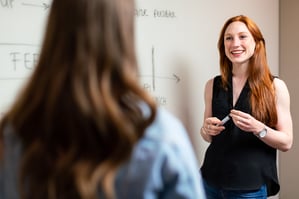When I had to move when I was in college, I did what most people do: I asked my friends for help. And, despite the busy lives they lead, they did. (Or, at least, many of them did. That’s right, I’m calling you out, Genevieve...) Now, I didn’t offer to pay my friends, but they helped me anyway. (I mean, I did bribe them with plenty of pizza, but no one volunteers to help you to move just for a few slices.)
The key to understanding why they helped me move is the idea of a “relationship bank account.”
A relationship bank account can be understood just like an actual bank account: You make regular investments over time, allowing you to make successful - and sometimes substantial - withdrawals when you need to. When we invest in relationships with others, we build up a healthy “account” with them so that, when we need something from them in the future, making a “withdrawal” is easy. I can’t imagine my friends would have helped me move if I hadn’t shown up for them at their slam poetry events, stayed up late at night on the phone with them post-breakup, or offered to grab them a coffee while I was out.
an actual bank account: You make regular investments over time, allowing you to make successful - and sometimes substantial - withdrawals when you need to. When we invest in relationships with others, we build up a healthy “account” with them so that, when we need something from them in the future, making a “withdrawal” is easy. I can’t imagine my friends would have helped me move if I hadn’t shown up for them at their slam poetry events, stayed up late at night on the phone with them post-breakup, or offered to grab them a coffee while I was out.
Making Withdrawals in the Relationship Bank Account
While your child likely doesn’t need to think yet about begging their friends to help them move, they will need to make other kinds of withdrawals — especially in school. Withdrawals in the world of academia can include things like requesting an extension on an assignment, asking to retake a test, seeking extra credit opportunities, or not wanting to read aloud when called upon. To be clear, your child might have all sorts of valid reasons for needing to make these kinds of withdrawals, but they’ll put themselves in a much better position to make them when they’ve made small deposits into their relationship bank accounts with their teachers over time. So the question then becomes: What might these deposits look like?
How to Make Deposits in the Relationship Bank Account
Making deposits can come in a range of forms. In any discussion-based classes, coming to class prepared with a question or point to offer would be a significant deposit. Whenever a teacher signals they’ll be asking for folks to read sections of a text aloud, volunteering to do so can be an easy investment in the relationship account. Other kinds of volunteering also work well, such as offering to write on the board if a teacher asks or expressing willingness to be the first to go for a presentation. Each of these deposits signals the student’s engagement in the class and commitment to participating in the classroom community in a positive manner.
Making the Strategy Fit Your Child
If your child isn’t eager to read aloud, write on the board, or be the first one up to present a project, that’s perfectly fine. Other kinds of deposits can include more subtle gestures, such as sending a strategic email or checking in with a teacher during study hall. With respect to strategic email, your child might communicate something positive about a recent class. For example, perhaps the teacher used an analogy to explain something and it just clicked. While it might only take your child a few minutes to write the message, it may have a long-lasting impact on the relationship. Some students might prefer to make in-person deposits by visiting a teacher during study hall. Visiting once every few weeks to review a concept in order to bolster their understanding of the material can be the ticket to demonstrating that they care about what they’re learning in the course. I mean, what teacher doesn’t want to know that their students care deeply about what they’re learning?
Now, you might be thinking, “Maria is a really great kid; her teachers love her! I am not sure if I need to explicitly suggest this.” Or you might be thinking, “I cannot imagine my painfully shy Derrick volunteering for anything or feeling comfortable enough to write an email or visit during study hall. Should I really be encouraging this?” If you’re unsure about exploring the idea of working on building up relationship bank accounts with teachers with your child, consider approaching their secondary school years as a great time to try something out before college - a time when relationship bank accounts can become even more essential.
Preparing for College
College poses a variety of complications to organically building relationships. Your child may wind up taking a class once per week, making relationship-building a real challenge with such infrequent formal meetings. Or your child may find themselves to be one of over 200 students in a large lecture hall, practically invisible to the professor. For most professors, teaching isn’t their sole responsibility; they likely have administrative duties alongside research and publication goals. This means that focusing on supporting students isn’t their sole job, and that reality is in stark contrast to most high school teachers. When we consider the context of college, it becomes clear that making investments will be critical. High school, therefore, is the ideal time to try making different kinds of deposits.
The Takeaway
Just like real banks have learned: interest matters. Demonstrating interest in other humans is a good way to get them to demonstrate interest in you, and teachers are, after all, human. Encouraging your child to make a little investment - thanking their teacher, volunteering in class, offering to help a classmate - might keep them from hearing their account is overdrawn when they need to borrow some kindness.
 Worried about the return to school? Tell us what's on our mind in our back-to-school survey.
Worried about the return to school? Tell us what's on our mind in our back-to-school survey.
Top Photo by ThisisEngineering RAEng on Unsplash

